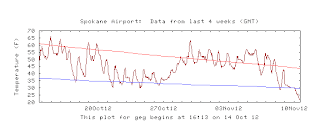Take a look at the temperatures on both sides of the Cascades for the past four weeks at Spokane, Sea-Tac, Olympia and Pasco--today is the coldest for all of them, with cold air aloft, few high clouds , and relatively light winds.. This combination allows the surface to radiate heat to space without a lot of mixing of warmer air down from above.
Here are the 24-h minimum temperatures ending at 7 AM Saturday. Quite a range...low 40s near the water, lots of 20s in the western Washington interior, with Olympia getting down to 21F (and you though Olympia was full of hot air!). Some teens and single digits in the mountains, and 20s in eastern Washington.
But the coldest regional temperatures in this kind of situation are usually in the valleys over the uplands of eastern Oregon. Here is the proof (only showed temps below 20F). Teens are nothing there and several locations had single digits.
Today will be a cool day (highs in the mid-40s) and many of you will see some sun as the fog and low clouds burn off. Unfortunately, the next weather system is moving in more quickly than expected a few days ago, with rain hitting the coast early Sunday and reaching the western interior by roughly 1-2 PM that afternoon (see graphic)--so enjoy the outdoors today. It will be perfect weather for raking leaves (my task this morning!)
 |
| Forecast precipitation for the 3-h period ending 1 PM Sunday. Note that "cin" means hundredths of an inch (32 is .32 inches in 3 hour) |
What you might not know is that this blog would surely not have existed without him. I was an undergraduate at Cornell and was really interested in both astronomy and meteorology. Sagan took me under his wings and we worked together on a model of the Martian atmosphere (my first publication). He impressed on me the need and importance for scientists to communicate directly with the public: that this is an essential requirement if science and society are to flourish. His impact on me was profound and this blog and my work at KPLU are an outgrowth of this influence. Sagan was not afraid to talk about the societal implications of his research, be it about the sustainability of our planet, the potential for nuclear winter, or the need for a scientifically literate population. When KUOW's Steve Scher gave me an ultimatum that I could only talk about weather on his Weekday program, and never about science/math education and the implications of my science, I thought of Sagan and knew what he would counsel. Better to be kicked off KUOW than compromise important principles.
Sagan is surely missed, but his influence and importance continue today.
 |
| Carl Sagan and me on my graduation day. I look a bit younger! |










Have you been noting some of the reports from NOAA about the extreme increases in specific humidity worldwide. I made a post about it here:
ReplyDeletehttp://yrihf.com/viewtopic.php?t=4447&sid=d0b5ab9f3574f789588e50b6b79064f5
What do you think?
That is too bad about KUOW, it is not only their loss, but also a disservice to their listeners. You would think KUOW of all stations would be supportive of your style!
ReplyDeleteAwesome
ReplyDeleteCarl was and always will be an inspiration. You too Cliff, thank you for all you do. Keep reaching out... we are out there.
ReplyDeleteThis idea of Sagan's - that scientists should talk directly to the public about science - is a great one with so many implications. My opinion is that not all scientists CAN speak the language of the layperson - so those that do have such a big impact. I often struggle through these posts (as a layperson myself) but what I can glean enables me to converse with my hydrogeologist husband about weather and observe the world around me in new ways. So valuable to me. So thanks, Carl and Cliff!
ReplyDeleteNever have left a comment before, though I read your blog regularly. But today, after reading your words about Carl Sagan -- wow!
ReplyDeleteI work in communications for a public agency, and often, our topic is science -- this post will be printed out and put up by my computer. Thanks for your blog, for your commitment to science and the public good and for the inspiration this morning!
Great work - we need more like you and Sagan!
ReplyDeleteDoes your model of the Martian atmosphere hold up after all these years?
ReplyDeleteCheers to Mass and Sagan for being excellent communicators of science!
ReplyDelete